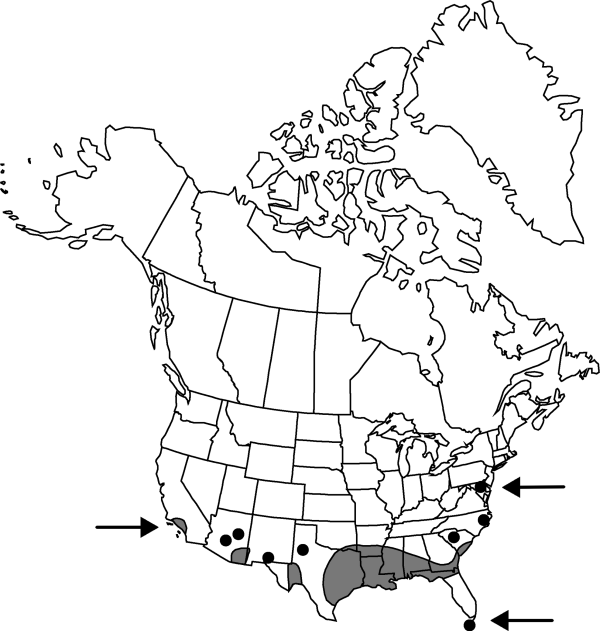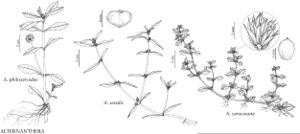Difference between revisions of "Alternanthera caracasana"
in A. von Humboldt et al., Nov. Gen. Sp. 2: 205. 1818.
FNA>Volume Importer |
imported>Volume Importer |
||
| Line 6: | Line 6: | ||
|place=2: 205. 1818 | |place=2: 205. 1818 | ||
|year=1818 | |year=1818 | ||
| + | }} | ||
| + | |special_status={{Treatment/ID/Special_status | ||
| + | |code=W | ||
| + | |label=Weedy | ||
| + | }}{{Treatment/ID/Special_status | ||
| + | |code=I | ||
| + | |label=Introduced | ||
| + | }}{{Treatment/ID/Special_status | ||
| + | |code=F | ||
| + | |label=Illustrated | ||
}} | }} | ||
|basionyms= | |basionyms= | ||
| Line 27: | Line 37: | ||
|elevation=0-2000 m | |elevation=0-2000 m | ||
|distribution=Ala.;Ariz.;Ark.;Calif.;Fla.;Ga.;La.;Md.;Miss.;N.Mex.;N.C.;Okla.;S.C.;Tex.;Mexico;Central America;South America. | |distribution=Ala.;Ariz.;Ark.;Calif.;Fla.;Ga.;La.;Md.;Miss.;N.Mex.;N.C.;Okla.;S.C.;Tex.;Mexico;Central America;South America. | ||
| + | |introduced=true | ||
|tables= | |tables= | ||
|references= | |references= | ||
| Line 49: | Line 60: | ||
|publication title=in A. von Humboldt et al., Nov. Gen. Sp. | |publication title=in A. von Humboldt et al., Nov. Gen. Sp. | ||
|publication year=1818 | |publication year=1818 | ||
| − | |special status= | + | |special status=Weedy;Introduced;Illustrated |
| − | |source xml=https:// | + | |source xml=https://bibilujan@bitbucket.org/aafc-mbb/fna-data-curation.git/src/bb6b7e3a7de7d3b7888a1ad48c7fd8f5c722d8d6/coarse_grained_fna_xml/V4/V4_887.xml |
|genus=Alternanthera | |genus=Alternanthera | ||
|species=Alternanthera caracasana | |species=Alternanthera caracasana | ||
Revision as of 23:20, 27 May 2020
Herbs, perennial, 1–5 dm. Stems prostrate to procumbent, villous, glabrate. Leaves sessile; blade rhombic-ovate, oval, or obovate, usually longer than broad, 0.5–2.5 × 0.3–1.5 cm, apex rounded, apiculate, sparsely villous, glabrate. Inflorescences axillary, sessile; heads white to stramineous, ovoid, 0.5–0.8 × 0.4–0.6 cm; bracts shorter than tepals, apex long-attenuate, aristate. Flowers: tepals dimorphic, whitish to stramineous, lanceolate, 3–5 mm, apex acuminate, spinose tipped, densely villous, hairs barbed; stamens 5; pseudostaminodes triangular or subulate, shorter than filaments, margins usually entire, rarely dentate. Utricles included within tepals, brown, ovoid-orbicular, 1.5 mm, apex slightly truncate. Seeds ovate-orbiculate, 1–1.5 mm.
Phenology: Flowering summer–fall.
Habitat: Gravel, sand bars, sidewalks
Elevation: 0-2000 m
Distribution

Introduced; Ala., Ariz., Ark., Calif., Fla., Ga., La., Md., Miss., N.Mex., N.C., Okla., S.C., Tex., Mexico, Central America, South America.
Discussion
Selected References
None.
